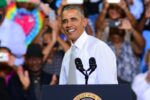Donald Trump Jr. pushed back against characterizations of his father as aspiring to monarchical power during a Fox News interview, making a pointed observation about the current president’s behavior that has drawn attention amid massive nationwide protests.
The younger Trump’s comments came after an estimated seven million Americans participated in “No Kings” demonstrations on Saturday, October 18, 2025, filling streets in cities from New York to Los Angeles to express concerns about what organizers described as presidential overreach and threats to democratic norms.
In the interview broadcast on October 22, Trump Jr. defended his father against accusations that he seeks king-like authority. “If he was a king, he probably would have never left the office the first time,” he insisted, referring to the peaceful transfer of power following the 2020 election. The president himself addressed the characterization directly in the same interview, stating that protesters were referring to him as a king but asserting he is not one.
Opponents of Trump Jr. pointed out that while his father did leave office in 2021, it was only after he did little to stop his supporters from launching a violent assault on the U.S. Capitol on January 6, 2021, in an attempt to block the election’s certification and remain in power.
The Fox News appearance served as counter-programming to the massive street demonstrations that drew crowds to more than 2,600 locations across the country. In New York City, over 100,000 people across all five boroughs, according to the police department, which reported no protest-related arrests. Demonstrators carried signs reading “Democracy not Monarchy” and “The Constitution is not optional.”
The protests represented the third major mobilization since Trump’s return to the White House in January 2025, following earlier demonstrations against government budget cuts and a June military parade. Organizers said the events remained peaceful despite warnings from Republican officials who had mobilized National Guard troops in several states ahead of the rallies.
In Washington, Independent Senator Bernie Sanders addressed the crowd from a stage, telling demonstrators they were not present because they hated America, but because they loved it. He warned that the American experiment faced danger under the current administration but expressed confidence that the people would prevail.
Republican leaders had attempted to discredit the protests in the days leading up to the events. House Speaker Mike Johnson of Louisiana referred to the demonstrations as a “hate America rally” and predicted they would attract what he called communists, Marxists, and those who hate capitalism. Several Republican governors, including Greg Abbott of Texas and Glenn Youngkin of Virginia, activated National Guard units in their states, though troops were largely not visible at the actual protests.
The demonstrations occurred against the backdrop of an ongoing government shutdown, which had reached its 18th day by the time of the protests. Senate Majority Leader John Thune maintained there was nothing to negotiate regarding Democratic demands for healthcare funding, while Democrats refused to vote for legislation that did not extend health subsidies.
Connecticut Senator Chris Murphy, speaking on CNN’s “State of the Union” on October 26, argued that Trump preferred keeping the government closed because it allowed him to exercise what Murphy described as king-like powers. Murphy suggested the shutdown gave the administration control over which departments could operate and which employees would be paid, comparing the situation to tactics used in totalitarian states.
Arizona Senator Mark Kelly told ABC that the president had spent only one hour negotiating with Democratic leadership since the shutdown began, contrasting that minimal time investment with extensive planning for a proposed $300 million White House ballroom renovation.
Many protesters expressed anger at being characterized as anti-American. In Washington, one demonstrator named Brian Reymann carried a large American flag and told reporters that being called a terrorist by Republicans was pathetic. He said he believed political opponents were misguided and power hungry, but did not doubt their love for the country.
The protests featured a carnival-like atmosphere in many locations, with marching bands, inflatable costumes, and large banners displaying the Preamble to the Constitution. Frog costumes emerged as a particular symbol of resistance, especially in Portland, Oregon.
Dana Fisher, a professor at American University in Washington and author of several books on activism, predicted that the October 18 events could represent the largest protest turnout in modern American history, with more than three million participants, based on registrations and a comparison to previous demonstrations in June.
The demonstrations extended beyond American borders, with solidarity protests occurring in cities such as London, Madrid, Barcelona, and others in Europe. Several hundred protesters gathered outside the United States embassy in London, while demonstrations in Toronto near the American consulate included signs reading “Hands off Canada.”
Trump spent the protest weekend at his Mar-a-Lago residence in Florida, where he hosted a fundraising event. Vice President JD Vance attended a military demonstration at Camp Pendleton in California on the same day, in what observers described as counter-programming to the protests.








